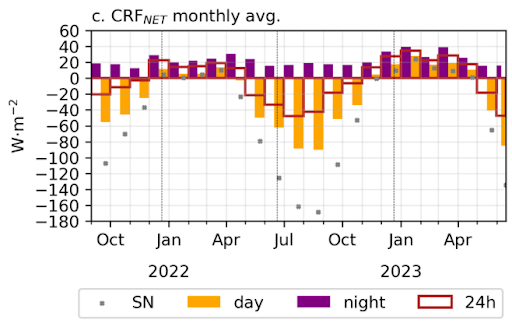Seasonality and albedo dependence of cloud radiative forcing in the upper Colorado River basin
Submitter
Feldman, Daniel — Lawrence Berkeley National Laboratory
Area of Research
Radiation Processes
Journal Reference
Rudisill W, D Feldman, C Cox, L Riihimaki, and J Sedlar. 2025. "Seasonality and Albedo Dependence of Cloud Radiative Forcing in the Upper Colorado River Basin." Journal of Geophysical Research: Atmospheres, 130(6), 10.1029/2024JD042366.
Science

Monthly average net Cloud Radiative Forcing (CRF) for the hour nearest solar noon (SN), day, night, and full 24-hr average time periods. The dashed vertical lines indicate the winter and summer solstices, respectively.
The hydrologic cycle is strongly influenced by the balance of sunlight and thermal radiation on the ground or snow surface. We quantify the combined impacts of clouds and snow cover on the surface radiative energy balance in a high-elevation region of the upper Colorado River basin. Since snow is bright and reflects sunlight, our results demonstrate that the surface energy balance will become increasingly sensitive to cloud cover as snow cover declines.
Impact
The results of this research serve directly as benchmarks for models, including those used for water resource management for both near- and far-term water resource allocation planning. We demonstrate the need for further scrutiny of the joint coevolution of both snow albedo and clouds on the future state of the Upper Colorado hydroclimate and mountain regions generally.
Summary
Clouds play a major role in the energy balance of mountain environments, yet their effects on surface radiation in high-elevation, snow-covered terrain are not well understood. This study analyzes nearly two years of data from the upper Colorado River basin at 2,880 meters elevation, collected as part of the SAIL field campaign, to quantify how clouds influence surface radiation—referred to as Cloud Radiative Forcing (CRF). In winter, when snow is bright and the air is dry, clouds trap outgoing heat and produce a warming effect, increasing net radiation by up to 34.7 W·m⁻² on average. In contrast, during the summer, when snow melts and monsoon clouds block sunlight, clouds cause a strong cooling effect, decreasing net radiation by up to 47.6 W·m⁻² on average—and up to 600 W·m⁻² near solar noon. The balance between warming and cooling depends strongly on the albedo (reflectivity) of the snow and ground surface. As climate change reduces snow cover, clouds are likely to have an increasingly cooling influence on mountain surface energy budgets.
Keep up with the Atmospheric Observer
Updates on ARM news, events, and opportunities delivered to your inbox
ARM User Profile
ARM welcomes users from all institutions and nations. A free ARM user account is needed to access ARM data.


















